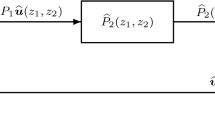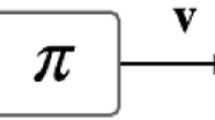Abstract
In this paper, we propose new joint serially concatenated communication structures constructed from convolutional product codes and space time codes. The proposed structures are suitable for parallel processing operations and they have very low decoding latencies compared to their classical counterparts. Use of multi-antennas increases the spectral efficiency of the joint structures.









Similar content being viewed by others
References
Berrou, C., Glavieux, A., & Thitimajshima, P. (1993). Near shannon limit error correcting coding and decoding : Turbo-codes. In Proceedings of ICC’93 (pp. 1064–1070). Geneva.
Franz, V., & Anderson, J. B. (1998). Concatenated decoding with a reduced search based BCJR algorithm. IEEE Journal on Selected Areas Communications, 16(2), 186–195.
Schurgers, C., Cattoor, E., & Engels, M. (2000). Optimized map decoder. In IEEE Workshop on Signal Processing Systems (pp. 245–254). Lafayette, LA.
Robertson, P., Villebrum, E., & Hoeher, P. (2015) A comparison of optimal and sub-optimal map decoding algorithms operating in the log domain. In IEEE International Conference on Communication (Vol. 2, pp. 1009–1013). Seattle.
Yoon, S., & Bar-Ness, Y. (2002). A parallel map algorithm for low latency turbo decoding. IEEE Communications Letters, 6(7), 288–290.
Wang, Y., Zhang, J., Fossorier, M., & Yedidia, J. S. (2005) Reduced latency turbo decoding. In SPAWC, IEEE 6th Workshop (pp. 930–934). Honolulu.
Gazi, O., & Yilmaz, A. O. (2006). Turbo product codes based on convolutional codes. ETRI Journal, 28(4), 453–460.
Tarokh, V., Seshadri, N., & Calderbank, A. R. (1998). Space-time codes for high data rate wireless communication: Performance criterion and code construction. IEEE Transactions Information Theory, 44(2), 744–765.
Zhipei, C., Zhongfeng, W., & Parhi, K. (2000). Iterative decoding of space-time trellis codes and related implementation issues. Asilomar Conference on Signals, Systems and Computers (Vol. 1, pp. 562–566). Pacific Grove.
Bauch, G. (1999) Concatenation of space-time block codes and turbo-tcm. In ICC ’99, IEEE International Conference on Communications (Vol. 1, pp. 1202–1206). Vancouver, BC.
Author information
Authors and Affiliations
Corresponding author
Rights and permissions
About this article
Cite this article
Gazi, O., Al-Kattan, A.A.S. Low Latency Hybrid Structures Involving Convolutional Product like Codes and Space Time Codes. Wireless Pers Commun 94, 745–754 (2017). https://doi.org/10.1007/s11277-016-3648-3
Published:
Issue Date:
DOI: https://doi.org/10.1007/s11277-016-3648-3




